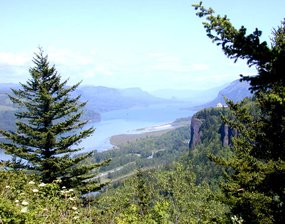Columbia River Gorge
|
|
|
Missing image Wpdms_nasa_topo_columbia_river_gorge.jpg The Columbia River Gorge |
|
Missing image Columbia_River_Gorge.jpg Columbia River Gorge, photographed from the southern edge of the Gifford Pinchot National Forest |
The Columbia River Gorge is a spectacular canyon of the Columbia River in the Pacific Northwest of the United States. Up to 4,000 feet (1300 m) deep, the canyon stretches for over 80 miles (130 km) as the river winds westward through the Cascade Range forming the boundary between the State of Washington to the north and Oregon to the south.
Extending roughly from the confluence of the Columbia with the Deschutes River down to eastern reaches of the Portland metropolitan area, the gorge furnishes the only navigable route through the Cascades. Inhabited since the time of the earliest arrival of humans in North America, the gorge provided the route in 1805 for the Lewis and Clark expedition to reach the Pacific Ocean. The gorge today holds federally protected status as one of the most popular recreational destinations in the region.
Description and History
Over the eons, the Columbia River has worn this deep gash into the volcanic rock of the Cascades, nearly down to sea level. The last major erosion occurred during the Missoula Floods during the ice age approximately 13,000 years ago. The most recent geological event was the Bonneville Slide in the 1700s, an event remembered in the local legends of the Native Americans as the Bridge of the Gods. Frequent rain nourishes a lush rain forest and replenishes the waters that cascade over the sheer basalt cliffs.
The western gorge is dominated by conifer, big-leaf maple, cottonwood, Oregon ash, and vine maple. The eastern gorge is home to big-leaf maple and Oregon white oak. The wide range of elevation and precipitation in the gorge creates a diverse collection of ecosystems from the temperate rain forest at Oneonta Gorge (with an average annual precipitation of 75 inches [190 cm]) to the Celilo grasslands (with average annual precipitation 12 inches [30 cm]). A large variety of endemic wildflowers thrives throughout the gorge.
The gorge has supported human habitation for over 31,000 years. Evidence of the Folsom and Marmes people, who crossed the Bering land bridge from Asia, were found in archaeological digs. Excavations near Celilo Falls, a few miles east of The Dalles, show humans have occupied this ideal salmon-fishing site for more than 10,000 years.
In addition to its natural beauty, the gorge also provides a critical transportation corridor and one of the most popular recreational locations in the Pacific Northwest. Atmospheric pressure differentials east and west of the Cascades create a wind tunnel effect in the deep cut of the gorge, generating 35 mph (56 km/h) winds that afford one of the finest and most famous board-sailing locations in the world.
The gorge also contains the greatest concentration of waterfalls in the Pacific Northwest, with over 77 waterfalls on the Oregon side of the gorge alone, including the notable Multnomah Falls, which, at 620 feet (188 m), is the second highest year-round waterfall in the United States.
In November 1986, the United States Congress recognized the unique beauty of the gorge by making it first U.S. National Scenic Area. (See: Columbia River Highway and Crown Point, Oregon).
External links and references
- Historic Columbia River Highway (http://www.columbiariverhighway.com/)
- Columbia River Gorge National Scenic Area (http://www.fs.fed.us/r6/columbia/forest/)
| State of Oregon | 
| ||
| Regions Columbia River Gorge and Plateau | Eastern Oregon | Inland Empire | Mt. Hood Corridor | Oregon Coast | Western Oregon | Willamette Valley | |||
| Counties | Largest cities (full list) | ||
| Baker | Benton | Clackamas | Clatsop | Columbia | Coos | Crook | Curry | Deschutes | Douglas | Gilliam | Grant | Harney | Hood River | Jackson | Jefferson | Josephine | Klamath | Lake | Lane | Lincoln | Linn | Malheur | Marion | Morrow | Multnomah | Polk | Sherman | Tillamook | Umatilla | Union | Wallowa | Wasco | Washington | Wheeler | Yamhill | Albany | Beaverton | Bend | Corvallis | Eugene | Grants Pass | Gresham | Hillsboro | Keizer | Lake Oswego | McMinnville | Medford | Milwaukie | Oregon City | Portland | Salem | Springfield | Tigard | Tualatin | West Linn | ||

